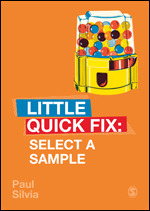Select a Sample
Little Quick Fix
- Paul Silvia - University of North Carolina at Greensboro, USA
Little Quick Fix
Quantitative/Statistical Research (General)
Whether students are working with existing data or generating their own, sampling is a deceptively complicated and anxiety-inducing process especially when participants are people. Pressured by the usual limitations on time, access, and resources, students can panic at the thought that sampling involves theory and calculations and make snap decisions that usually lead to convenience sampling and ultimately, weak research claims. This Fix takes the panic out of sampling designs and helps students understand what sampling is, how it applies to different types of situations, and how to decide what approach works best for their project so they can maximize the impact of their research. It covers questions like:
· What is sampling?
· What is my population?
· Should I use probability sampling?
· Should I use subjective, non-probability sampling?
· How do I sample from ill-defined, hard-to-reach, and wary populations?
· How can I sample people ethically?
· How can I reduce error and bias in sampling?
· How large should my sample be?
Students need help over hurdles at every stage of their research project. They want simple, powerful, accessible tools that deliver results fast. They need to meet interim assessment deadlines and prove that they have successfully passed through multiple stages of their project, or need to master a stage of understanding in a learning cascade before they can proceed to the next week in their methods module.
Their supervisors are increasingly unable to help, but will still be assessing results. Students need more than YouTube.
Titles in the Little Quick Fix series offer:
· Visual, design-led learning
· Clear, structured, useful pedagogy
· A hand-holding, step-by-step approach for students who are less able, or less academically prepared by school so far
· Effective self-directed learning with DIY progress tracking
· A stand-in for the busy/unavailable supervisor
The book is simple to understand and nicely illustrated for the visual learner. It is suitable for degree student as a preliminary concept and understanding before taking the research methodology class.
Sampling for data on social science and humanities are integral process and the book has given a clear process for data acquisition and processing.










